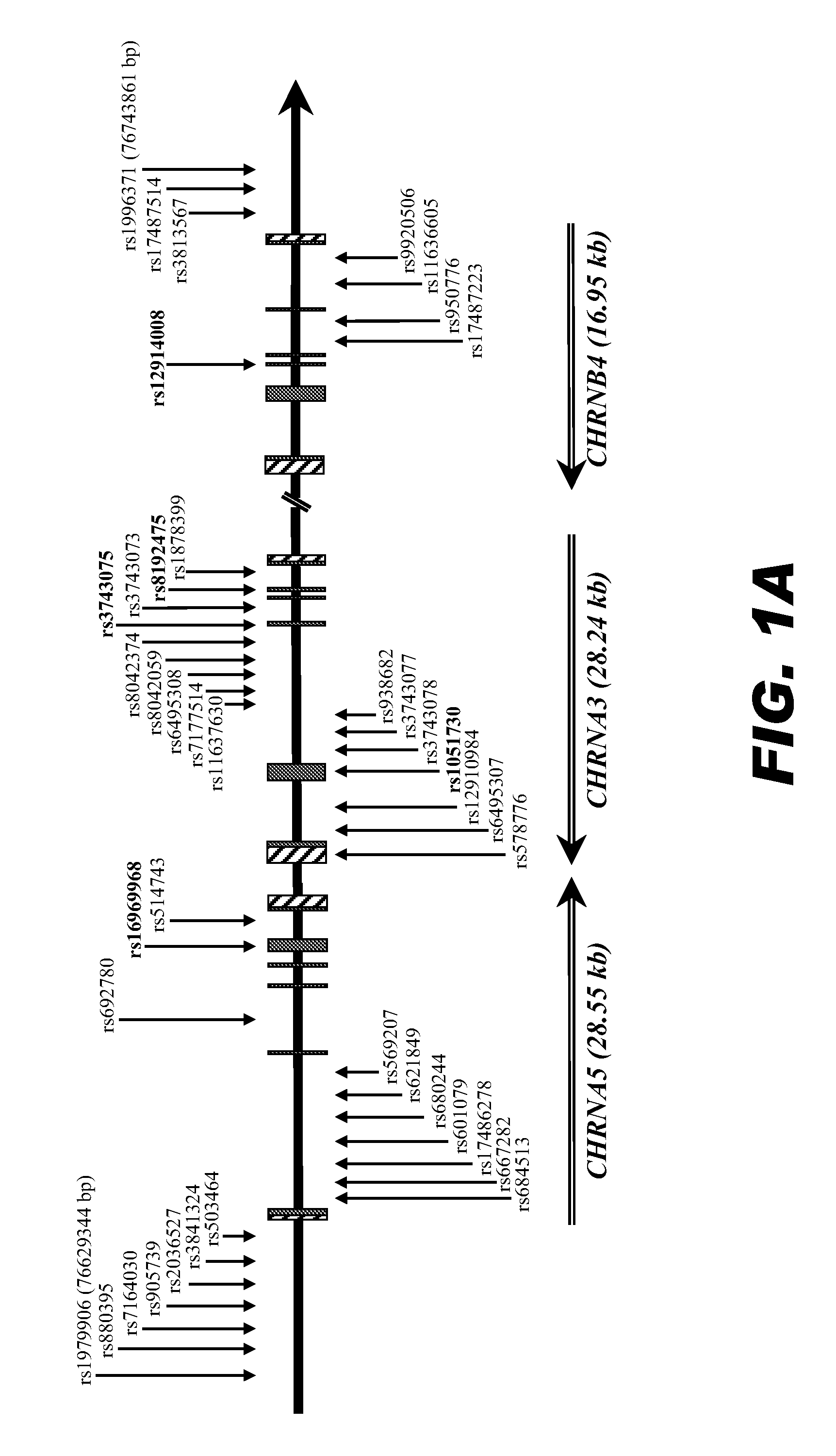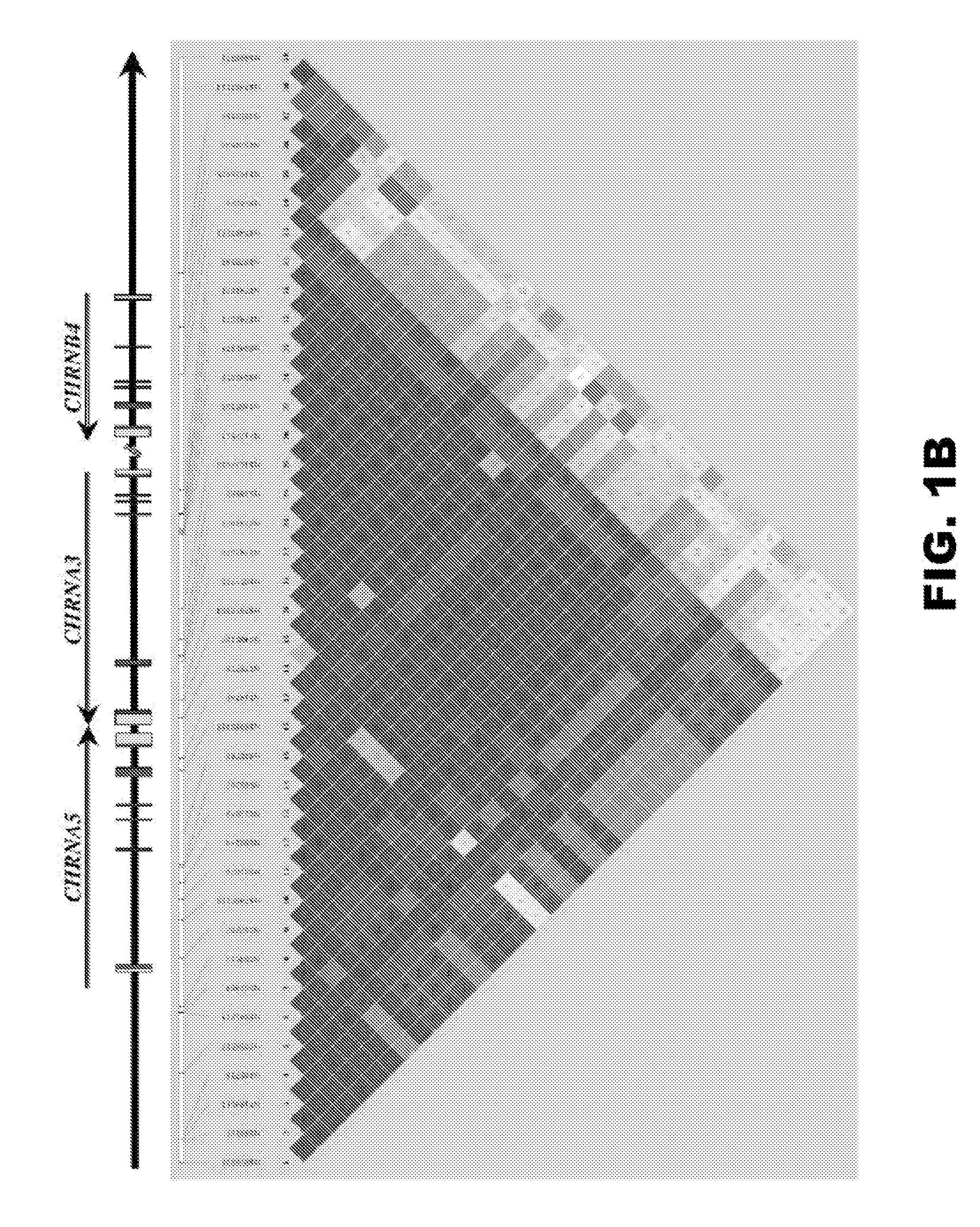Genetic polymorphisms and substance dependence
a technology of gene polymorphisms and substance dependence, applied in the direction of biocide, amide active ingredients, drug compositions, etc., can solve the problem and achieve the effect of increasing the risk of substance dependen
- Summary
- Abstract
- Description
- Claims
- Application Information
AI Technical Summary
Benefits of technology
Problems solved by technology
Method used
Image
Examples
example 1
Genetic Variants in the CHRNA5-CHRNA3-CHRNB4 Gene Cluster are Associated with Alcohol Dependence in the Collaborative Study on the Genetics of Alcoholism Dataset
[0064]A comprehensive genome wide association study and a candidate gene study using nicotine dependent smokers as cases and non-dependent smokers as controls demonstrated significant association between several genetic variants in nicotinic acetylcholine receptors (nAChR) and nicotine dependence (Bierut et al., Hum Mol Genet 2007, 16:24-35; Saccone et al, Hum Mol Genet 2007, 16:36-49). Since the CHRNA5, CHRNA3, and CHRNB4 genes, which encode the α5, α3, and β4 subunits of nAChR, respectively, cluster together on chromosome 15q, a comprehensive association analysis was performed with this gene cluster in the Collaborative Study on the Genetics of Alcoholism (COGA) families to investigate the role of genetic variants in these three nAChRs in risk for alcohol dependence.
[0065]Study subjects. Alcohol-dependent probands, defined...
example 2
Replication Study with the Family Study of Cocaine Dependence (FSCD)
[0072]To further examine the genetic contribution of SNPs in this gene cluster with respect to risk for alcohol dependence, SNP 6 / rs38413234 and 10 other SNPs in linkage disequilibrium with SNP 6 / rs38413234 (in European Americans) were genotyped in an independent dataset from the FSCD.
[0073]Study subjects. Unrelated cases and matched unrelated controls within the candidate-gene study of the FSCD were used for this study. Cocaine dependent subjects were recruited from publicly and privately funded inpatient and outpatient chemical dependency treatment centers in the St. Louis area. Eligibility requirements included meeting DSM-IV criteria for cocaine dependence, being 18 years of age or older, speaking fluent English, and having a full sibling within five years of their age who was willing to participate in the family-arm of the study. Control subjects were recruited through driver's license records maintained by the...
example 3
Allelic Differences in Expression of the CHRNA5 Gene in Human Frontal Cortex
[0077]To determine whether the SNPs associated with alcohol dependence have a direct effect on gene expression, the levels of CHRNA5 mRNA were analyzed in human brain tissue obtained from the Alzheimer's Disease Research Center (ADRC) of Washington University in St. Louis.
[0078]Gene expression analyses. Postmortem brain tissues derived from frontal cortex of 48 unrelated, non-demented adults were obtained from the brain bank at the Alzheimer's Disease Research Center (ADRC) of Washington University in St. Louis (http: / / alzheimer.wustl.edu / ). DNA and total RNA was extracted from brain tissues using Qiagen's DNeasy Blood & Tissue Kit and RNeasy Lipid Tissue Kit (http: / / www.qiagen.com), respectively. A cDNA library was prepared from total RNA using the High Capacity cDNA Archive Kit (http: / / www.appliedbiosystems.com).
[0079]Genomic DNA from all subjects was genotyped for the promoter polymorphism, SNP 6 / rs384132...
PUM
| Property | Measurement | Unit |
|---|---|---|
| Sensitivity | aaaaa | aaaaa |
| Correlation function | aaaaa | aaaaa |
Abstract
Description
Claims
Application Information
 Login to View More
Login to View More - R&D
- Intellectual Property
- Life Sciences
- Materials
- Tech Scout
- Unparalleled Data Quality
- Higher Quality Content
- 60% Fewer Hallucinations
Browse by: Latest US Patents, China's latest patents, Technical Efficacy Thesaurus, Application Domain, Technology Topic, Popular Technical Reports.
© 2025 PatSnap. All rights reserved.Legal|Privacy policy|Modern Slavery Act Transparency Statement|Sitemap|About US| Contact US: help@patsnap.com



